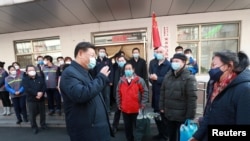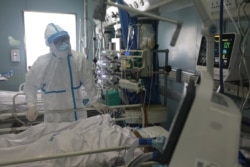China's state media has published a speech that President Xi Jinping delivered on February 3 about his involvement with the country's response to the coronavirus epidemic. The speech was published late Saturday.
Local Chinese officials have been criticized for their handling of the virus outbreak, while the president's involvement was been downplayed, until now.
The publication of Xi's speech, however, has done little to squelch questions about China's management of the response.
The president apparently handed down instructions on combating the virus on January 7 and he ordered the shutdown of Hubei province.
"On Jan. 22, in light of the epidemic's rapid spread and the challenges of prevention and control, I made a clear request that Hubei province implement comprehensive and stringent controls over the outflow of people," Xi told a meeting of the top leadership of the Communist Party.
Officials from the Wuhan - the city where the virus apparently emerged - and from Hubei - the province were Wuhan is located - have been fired by the Communist Party because of what was perceived as their inadequate response to the virus emergency.
The speech also seems to indicate the country's top leaders were slow to release information about the severity of the virus.
A young doctor who took to social media to issue a warning about the emerging virus was upbraided by local police. The doctor later died from the virus.
Meanwhile, Hubei's provincial government said Sunday that it will prohibit vehicle traffic across the province in an effort to stop the spread of the virus. Emergency and public service vehicles will be exempted.
The World Health Organization said late Saturday there are 50,580 "laboratory-confirmed" cases of the coronavirus around the world, with the vast majority of the cases - 50,054 - located in China.
A change in counting new cases
China's statistics, however, differ from those of WHO because China's government recently changed its methodology for diagnosing and counting new cases, causing a spike in the numbers of reported cases. Under the new method, doctors can use lung imaging and other analyses to diagnose a patient instead of relying on laboratory testing.
China says nearly 1,700 people have died from the virus and more than 68,000 people have been infected. The health commission confirmed 1,843 new cases Sunday, representing a drop from higher numbers of new cases in recent days. Over the previous two days, China had reported more than 7,500 new infections.
China's National Health Commission said Saturday that most of the new deaths were in Wuhan.
The risk assessment for the virus is "very high"in China and is "high" for the rest of the world, WHO said.
An 83-year-old American woman who was a passenger on a cruise ship docked in Cambodia has tested positive twice for the virus after leaving the ship. She and her husband and other passengers from the MS Westerdam traveled to Malaysia after no one on the vessel tested positive. Her husband continues to test negative.
China and WHO have launched a joint probe into the coronavirus. "We're concerned about the lack of urgency in funding the response from the international community," WHO Director-General Tedros Adhanom Ghebreyesus said at the annual Munich Security Conference.
Self-quarantine policy
Officials in China's capital have initiated a 14-day self-quarantine policy for all people returning to Beijing. The state-run Beijing Daily newspaper reports that those who refuse to seclude themselves or violate other containment rules "will be held accountable under the law," but is was not immediately clear what the consequences of refusing to self-isolate would be.
An 80-year old Chinese tourist died Friday in a hospital in Paris. He was the first person in Europe to die of complications from the virus.
In addition, the first coronavirus infection on the African continent has been reported in Egypt.
The Diamond Princess, a quarantined cruise ship docked in Yokohama, has reported another 70 virus-infected people, bringing the ship's total cases among the nearly 4,000 passengers and crew to 355. "We must anticipate a spread of infections," Japanese Health Minister Katsunobo Kato said Sunday.
Canada, Hong Kong, South Korea and the U.S. say they are sending planes to Japan to evacuate their citizens from the ship.


